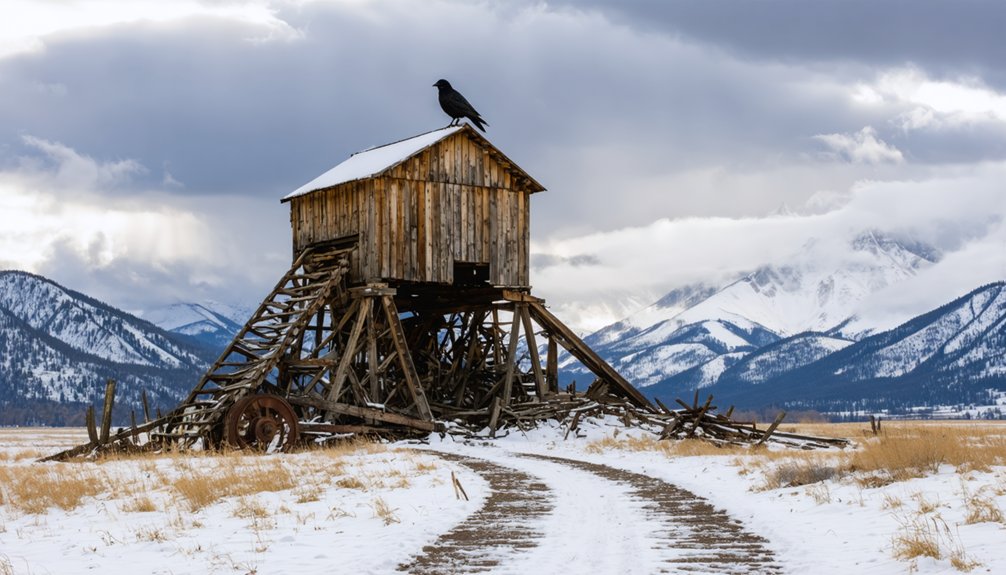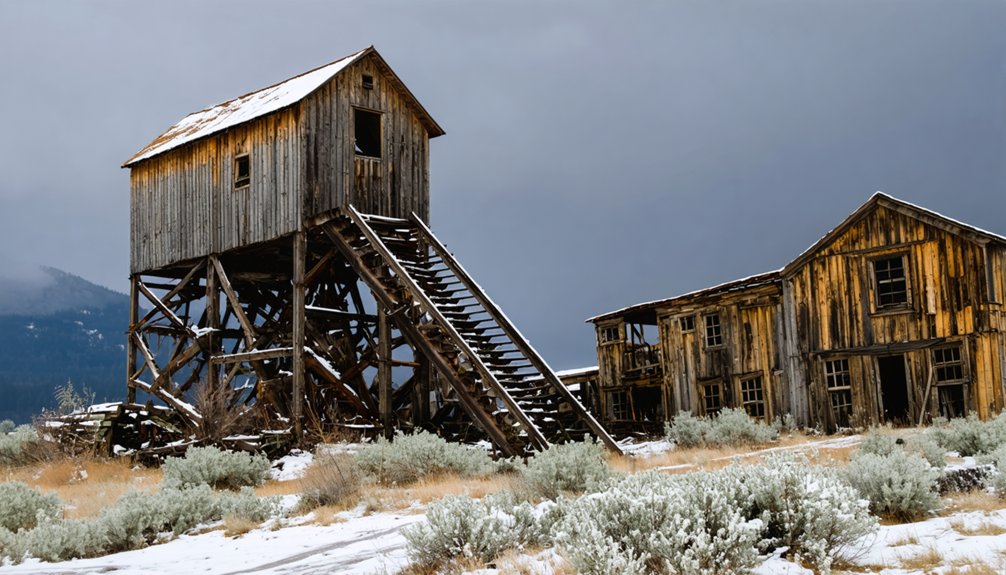You’ll find the Greyhound Mine perched at 8,000 feet in Idaho’s Challis National Forest, where from 1900 to 1910 miners extracted silver and gold from five major adits. The operation’s smelter and processing facilities, built by Greyhound Mountain Mining Company in 1905, helped generate over $12.5 million in precious metals. Today, the well-preserved ghost town features historic mining infrastructure, offering glimpses into the challenging lives of high-altitude miners.
Key Takeaways
- The Greyhound Mine operated in Custer County, Idaho from 1900-1910, producing over $10 million in silver during its peak years.
- Located at 8,000 feet elevation, miners endured harsh conditions in metal shacks with shared facilities and extreme weather challenges.
- The site features five major mining adits, including Upper and Lower Rufus, plus remnants of a smelter built in 1905.
- Mining operations included extensive underground developments, processing facilities, and living quarters, now preserved as historical mining infrastructure.
- The abandoned mining camp stands as a testament to Idaho’s silver rush era within Challis National Forest.
The Silver Rush Years: 1900-1910
Three major factors defined the Greyhound Mine‘s brief but intense silver rush period from 1900 to 1910.
First, the discovery of rich silver veins led to the construction of the Upper Rufus Adit, stretching 170 meters into Sulfur Creek’s mineral-laden depths.
Rich silver discoveries sparked construction of the Upper Rufus Adit, tunneling deep into Sulfur Creek’s promising mineral deposits.
Second, you’ll find the turning point in 1905 when the Greyhound Mountain Mining Company built their vital smelter, enabling on-site processing of high-grade silver, gold, lead, and zinc ore.
Third, a devastating economic downturn struck in 1910, forcing operations to cease despite the area’s proven mineral wealth. Like many mines in northern Idaho, the operation left behind contaminated sediments that would impact the environment for decades to come.
The region’s community resilience showed through the rapid development of infrastructure, including railways and housing, but couldn’t withstand the silver market’s collapse. Historic newspaper articles from this era reported bonanza grade discoveries at the Bulldog Mine, with some samples reaching over 35,000 g/t gold.
While neighboring districts like Bayhorse and Clayton had seen $10 million in production by 1898, Greyhound’s promising future ended abruptly with the 1910 crash.
Mining Operations and Technology
You’ll find Greyhound Ridge’s early mining operations centered around onsite smelting facilities that processed high-grade silver and gold ore from 1900 to 1910.
The underground development progressed through five major adits driven into the mountain, with the Bulldog and Greyhound mines emerging as primary producers. A 1979 bulk sample analysis demonstrated the continuing mineral potential, yielding impressive grades of 2.39 g/t gold and 1953 g/t silver. Recent exploration efforts have integrated portable XRF technology for immediate mineral analysis at the site.
The miners employed hand drilling and blasting techniques to extract ore from veins 5 to 15 feet thick, developing horizontal tunnels that accessed the richest mineralized zones.
Early Smelting Methods
During the early mining days at Greyhound Mine, ore processing relied heavily on both mechanical and chemical methods to extract valuable metals.
You’d find miners using Mexican arrastras and stamp mills to crush the ore before applying more advanced smelting techniques. The operation’s core refinement process centered around amalgamation with mercury, particularly effective for silver-bearing ores. Square-set timbering provided crucial support for the mine’s underground operations where the ore was extracted.
The mine’s smelting operations utilized charcoal-fired bloomery hearths, where you’d see water-powered bellows forcing air through the furnace to achieve higher temperatures. The incorporation of waterpower technology dramatically improved the efficiency of ore processing, following medieval European innovations.
As operations expanded, more sophisticated blast furnaces improved the efficiency of metal extraction.
Chemical leaching processes, including the groundbreaking cyanide method of the 1880s, allowed miners to process complex ores that mechanical crushing alone couldn’t handle effectively.
Underground Development Evolution
The underground development at Greyhound Mine began in earnest with the excavation of multiple adits into Greyhound Ridge between 1896 and 1910.
You’ll find evidence of five adits from this era, including the notable Upper Rufus Adit extending 170 meters into the ridge.
These early mineral exploration efforts utilized hand drilling and black powder blasting to follow high-grade silver and gold veins. The property’s twelve patented claims encompassed multiple historic workings that traced mineralization across the site. The mine operated at a considerable elevation of 7,999 feet, making access and operations challenging during winter months.
Geological Treasures and Mineral Wealth
Located at an elevation of 7,999 feet in Idaho’s Seafoam Mining District, Greyhound Mine‘s geological profile reveals significant deposits of silver, gold, and antimony.
The site’s mineral deposits have attracted exploration since the early 1900s, when the area flourished as a bustling silver mining camp. The mine’s documented minerals include arsenopyrite and galena, which were key indicators of valuable ore deposits.
You’ll find that modern geological exploration at Greyhound Mine employs cutting-edge technologies like portable XRF spectrometry to reveal its hidden potential.
While historical mining operations were limited by outdated technology, today’s advanced sampling methods and geological mapping techniques are uncovering promising new targets.
Under Metallis Resources’ recent acquisition in 2024, the property’s untapped wealth is being systematically evaluated through rock and soil sampling.
A planned drilling campaign in late 2024 aims to further assess the site’s mineralized zones.
Life in a High-Altitude Mining Camp
Living at nearly 8,000 feet elevation, miners at Greyhound Mine endured harsh conditions that tested both physical and mental resilience.
You’d find workers packed into corrugated metal shacks with minimal insulation, battling year-round freezing temperatures and constant snowfall risks. The shared bathroom facilities were especially challenging during the brutal winter months. The high altitude health challenges were relentless – from altitude sickness to chronic hypoxia affecting your heart and lungs.
Despite these brutal mining camp conditions, you’d witness an extraordinary spirit of camaraderie.
Workers from diverse backgrounds shared cramped quarters, fought through long shifts operating heavy machinery, and developed critical support networks. They’d gather during meals and breaks, finding psychological respite in their shared experience.
While medical infrastructure remained limited, miners adapted through communal resilience and makeshift solutions to survive the harsh environment.
The Modern Explorer’s Guide

Modern explorers seeking to visit Greyhound Mine will find it nestled in Custer County‘s Challis National Forest, approximately 41 kilometers north-northwest of Stanley, Idaho.
You’ll need to navigate established vehicular routes to reach this high-altitude site at 7,999 feet, where you’ll encounter remnants of historical mining infrastructure, including the Upper and Lower Rufus adits.
Before planning your exploration techniques, be aware that the mine’s 124 hectares include both public and private patented claims.
You’ll need proper permissions and must comply with environmental regulations enforced by the Challis National Forest.
While examining the polymetallic deposits, you can access multiple adits that showcase silver, gold, lead, and zinc mineralization zones, though you should exercise caution around these historical workings.
Legacy in Idaho’s Mining History
You’ll find the Greyhound Mine’s impact deeply woven into Idaho’s early silver rush history, with its 1900s operations representing a vital chapter in Custer County’s mineral development.
The mine’s polymetallic ore production, including silver, gold, lead, and zinc, helped establish Idaho’s reputation as a significant mining territory during the state’s formative years.
Beyond its economic contributions, the Greyhound Mine fostered a vibrant mining community that, like many others across Idaho, transformed from a bustling industrial hub into a monument of the state’s rich mining heritage.
Early Silver Rush Impact
The Greyhound Mine played a vital role in Idaho’s late 19th-century silver rush, contributing to the region’s $10 million production value by 1898.
You’ll find evidence of its economic significance in the five adits driven between 1896 and 1910, where high-grade silver discovery sparked intensive mining operations at both Greyhound and Bulldog sites.
The mine’s output helped establish essential local infrastructure, including an on-site smelter that processed ore from multiple shafts and pits.
When metal prices declined around 1910, the region experienced a revival phase through 1925, generating an additional $2.5 million in production value.
The Greyhound’s silver grades significantly exceeded those of many other Idaho underground operations, marking it as a standout producer during the territory’s formative mining years.
Mining Community Cultural Heritage
Deep within Idaho’s mining legacy, Greyhound Mine stands as a tribute to late 19th-century industrial innovation and community development.
You’ll find its rich history embedded in the Challis National Forest at 8,000 feet, where from 1896 to 1910, miners extracted silver, gold, and lead, shaping the region’s identity.
The mine’s cultural preservation spans technological evolution, from traditional adits to modern XRF spectrometry.
Community stories revolve around the mine’s smelter, which served as a cornerstone of local infrastructure and economic growth.
While specific preservation efforts aren’t documented, you can trace the mine’s influence through the development of nearby settlements, where it attracted pioneers and created jobs, contributing to Idaho’s broader mining heritage and the transformation of its mountain communities.
Frequently Asked Questions
How Dangerous Is It to Explore the Abandoned Mine Tunnels Today?
Dark, deadly dangers await you’re exploring: mine safety’s nonexistent and tunnel hazards include unstable roofs, toxic gases, flooding, vertical shafts, and contaminated materials. You’ll risk entrapment, injury, or death.
Are There Any Paranormal Activities Reported at the Greyhound Mine Site?
You won’t find documented ghost sightings or eerie sounds at this location. Despite its status as an abandoned mine, there aren’t any verified paranormal activities reported in historical records or local accounts.
What Wildlife Species Commonly Inhabit the Old Mine Site Now?
You’ll spot diverse wildlife including elk herds, lynx, mountain goats, bats roosting in old shafts, sage-grouse in nearby steppes, and bull trout in surrounding streams and thermal springs.
Can Visitors Collect Mineral Specimens From the Mine Dumps Legally?
You can’t legally collect minerals here since it’s on patented mining claims. You’ll need explicit permission from the claim owner before removing any specimens from dump sites.
What Was the Total Population of the Mining Camp at Its Peak?
Like scattered gold flakes in a miner’s pan, exact numbers elude you. During the mining history peak around 1906-1910, you’d have found several hundred residents, with seasonal gold rush fluctuations between 200-500 people.
References
- https://metallisresources.com/wp-content/uploads/2024/08/Greyhound_Presentation_July_2024.pdf
- https://westernmininghistory.com/mine-detail/10070826/
- https://www.mining-technology.com/news/metallis-exploration-greyhound/
- https://thediggings.com/mines/usgs10070826
- https://history.idaho.gov/wp-content/uploads/2018/08/0009.pdf
- https://www.lib.uidaho.edu/idahobibliography/items/ibp757.html
- https://www.mindat.org/loc-138415.html
- https://www.mindat.org/loc-137480.html
- https://www.newswire.ca/news-releases/metallis-provides-update-on-greyhound-targets-and-uncovers-historical-records-of-bonanza-gold-801698878.html
- https://metallisresources.com/wp-content/uploads/2024/02/Greyhound_Presentation_February_29_2024_FINAL.pdf



